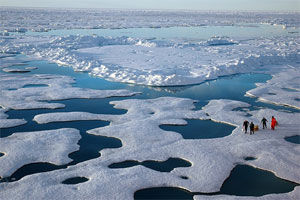As the Arctic ice caps melts away, vast new shipping routes and oil and mineral resources are being revealed that are too appealing to ignore.
The route from Russia through the Arctic cuts travel time between Europe and Asia some 40% and is expected to get about a quarter of cargo traffic by 2030. Gas and oil from the Arctic will also be transported.
Just two decades ago, most of the Arctic Ocean was covered in ice all year long, but in September of 2012, the Arctic ice cap reached the lowest level ever, opening the sea route for six months. Summers are expected to be ice-free by 2030-2040 as the Arctic heats up twice as fast as the rest of our planet.
Only four ships crossed the Northern Sea Route in 2010, but that rose to 46 ships last year.
20% of the world’s oil and gas reserves are in the Arctic.

Arctic Council Meets
Every two years, The Arctic Council meets to discuss its fate and as it opens to development, many countries are jockeying to join the increasingly important group. It has traditionally consisted of the US, Canada, Russia, Denmark, Finland and Norway.
This year, six countries were given observer status: China, India, Italy, Japan, Singapore and South Korea. The European Union’s status remained up in the air because of a dispute with Canada. The EU has banned imports of Canada’s seal products (intended to stop the brutal clubbing of baby seals each spring). Greenpeace and the Association for Oil and Gas Producers also applied for observer status, but were rejected.
They discuss such issues as oil and mineral exploitation, shipping, tourism and fishing, and environmental protection.
The May 15th meeting in Sweden
resulted in "Vision for the Arctic," which has these sections:
- A Peaceful Arctic: nations can get along without a new international treaty
- The Arctic Home: importance of safeguarding indigenous rights)
- A Prosperous Arctic: the importance of economic cooperation between Arctic states and sustainable development, rather than relying on foreign investment
- A Safe Artic: safe shipping based on regional and international cooperation
- A Healthy Arctic Environment: the unique, fragile environment needs protection
- Arctic Knowledge: importance of integrating scientific and indigenous knowledge
- A Strong Arctic Council: the eight Arctic countries will maintain control.
The only binding agreement adopted is that Council members will jointly develop a plan to prepare for and coordinate responses to potential oil and gas spills that will result from increased exploration. Two years ago they agreed to coordinate search and rescue missions in the Arctic Ocean.
It’s final declaration for the year recognizes "the central role of business in the development of the Arctic," and called for that development to be conducted in ways that sustain indigenous peoples and the environment.
Canada Takes the Reins
This year, Canada takes over the leadership of the Arctic Council from Sweden, followed by the US in 2015.
For the next two years, Canada vows "unprecedented industrial development," starting with the launch of a pan-Arctic business forum this year to begin "spurring trade and development" among the Arctic states, The Globe and Mail reports. Besides oil, there are rich reserves of gold, tin, lead, nickel and copper.
At the same time, indigenous groups signed the Joint Statement of Indigenous Solidarity for Arctic Protection, which protects the Arctic from oil and mining development that threatens the environment.
"We will not stand by and let the Harper government use the next two years to advance its destructive industrial agenda at the Arctic Council," says Christy Ferguson of Greenpeace.
US Strategy for the Arctic
About a week before the meeting, the US released its strategy for the Arctic, which outlines three concerns: advancing national security interests; managing the Arctic ecosystem responsibly and bolstering international relationships.
The goal is to balance energy and minerals development with environmental conservation.
The White House will develop an implementation plan for the interagency effort in the coming months.
Of course, the Arctic’s polar bears, beluga whales, narwhals and other rare creatures are caught in the crosshairs.
Frances Beinecke, president of the Natural Resources Defense Council says:
"Imagine if Yellowstone National Park were suddenly thrown open to drilling or the waters of Acadia National Park became a thoroughfare for container ships. Americans would not let these treasures of our natural heritage become industrialized, because we have learned the value of setting aside wild and unique places.
We have a chance to apply those lessons in the Arctic, one of the wildest and most unique places on the planet. But we must move quickly, before polluting industries despoil the region’s marine ecosystems beyond repair."
Although the White House strategy makes its drive for energy development clear it falls short on details for how to preserve fragile ecosystems, she adds.
How about rebuilding the Arctic ice cap?
Here is the White House strategy:


 Loading...
Loading...
The opening of the Arctic is generating a lot of interest in its commercial potential. Demand for improved infrastructure will generate investment. http://thirdeyeosint.blogspot.com/2013/06/the-arctic-is-open-for-business.html